
Legacy of the Old McMillan Tanneries of Somerset County, Pennsylvania |
Team of Local Historians Conserves and Digitizes Pre-Civil War Tannery Ledger Filled with Everyday Detail |
A good tannery was a staple of farming communities during the 1800s and early 1900s before automobiles replaced horses as a primary mode of transportation. A tannery’s purpose in its heyday was to transform cattle hides brought in by farmers into a host of leather tools for farm use as well as for personal clothing such as shoes and boots.
The McMillan/McMillen family tanneries of southern Somerset County played such a role in the 1840s, '50s and '60s. Founded by John McMillan, who had migrated from Dauphin County, PA, it first was located at Fort Hill, PA, on what later was known as the A.J. Case farm. The 1906 book History of Bedford and Somerset Counties states that John "had no vats or leeches, and took large chestnut logs and made troughs in which to lime bait and tan his hides. He was probably the first tanner in Somerset county."
Owned by John's son John Kirkpatrick McMillan and grandsons sons Jehu, John and Jacob, the tanneries served a wide swath of the population. The Meyersdale Republican once said that "The McMillans were noted tanners and harness-makers, or what was known in their times as saddlers." In addition to Fort Hill, they were located over the years in the small communities of Listonburg, New Lexington and New Centreville.
 |
Above: Pre-Civil War map of the site of the Jehu McMillan tannery in a compound with a woolen factory and shoe shop at Listonville, PA. Library of Congress. Below: site of the Jacob R. McMillan tannery in New Lexington, Somerset County, 1876. |
 |
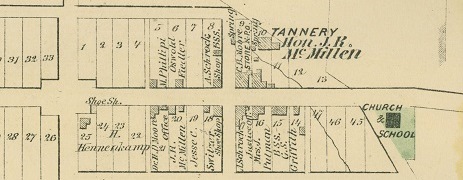 |
Included in the McMillans’ customer base were scores of the Minerd-Miner, Harbaugh, Ream, Younkin and Hartzell clans, among many, many other early settlers in the region. The business was not limited to the immediate southern Somerset area. One notation from August 1856 shows that the firm was “hauling hides” from as far away as Connellsville in neighboring Fayette County, PA, a distance of 31 miles from Listonburg by mountain road. The tanneries appear to have been profitable as evidenced by the number of customers and years in business. They employed local men to furnish work in and around the facility, such as harvesting crops, pruning trees, cutting and hauling boards and mending fences.
In addition to the individual customer accounts, the ledger provide a window into the political and religious leanings of the McMillan family at the time. In a letter from James and Margaret McMillen, to John K. and Sarah McMillen, pasted into the ledger, the final blue-inked inscription at the bottom reads “Huzza for Polk” -- referring to the 1844 political campaign of President James K. Polk. In 1851, records show that the family subscribed to the weekly Christian Advocate newspaper of the Methodist Episcopal Church for the annual fee of one dollar.
"Huzza for Polk" 1844 presidential election note found in the ledger |
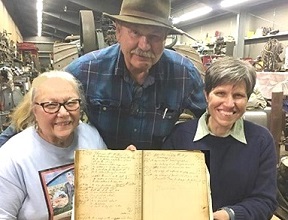 |
|
|
When required to file a business report in 1878 with the Secretary of Internal Affairs of Pennsylvania, Jehu disclosed that his firm in Listonburg employed two people who were paid $465 in annual wages, and that it was capitalized at a value of $1,215. The tannery also bore $750 in annual expenses for materials "such as hides and skins, bark, oil, tallow, &c." Jehu's business in 1881 carried the name "White's Creek Tanneries."
Jehu later turned his firm over to his son Charles R. McMillan, who operated it in 1906 using " the old methods, being the last one to conduct business along those lines," said the Bedford/Somerset history. His success gave him the means and opportunity to invest his time and resources in local economic development projects, "being a promoter of nearly every industry in the community."
Working at a tannery was highly unpleasant, filthy and smelly. Once a hide or skin arrived, it underwent a series of steps to get rid of fat, hair, bacteria and salts. Fur was removed through soaking in animal urine, a highly noxious process which stunk and if not handled carefully often led to lung infections in the workers. Other steps in the process included treating skins with milky lime and salt bath followed by a drying process. Additional dangers lurked in the operation of machinery.
Jehu McMillan is known to have suffered a painful accident in April 1881 as reported in the Somerset Herald, while cutting ice away from the frozen waterwheel used at the bark mill of his facility:
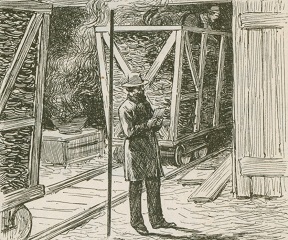 |
|
|
After he had removed a portion of the ice the wheel started, throwing Mr. M. off his feet and into the wheel. The water which had been turned on so that the wheel would start as soon as it cut loose kept it in motion, and was soon making rapid revolutions. Mr. M. succeeded in getting hold of one of the middle braces of the wheel to which he clung with a death grip at the same time calling loudly for help, but unfortunately no one heart him. He had been in this condition, he thinks, about an hour when his son started for the tannery; nearing the mill-house he heard his father, who by this time had become quite hoarse from his continued and energetic efforts to make some one hear. The son first attempted to stop the wheel by shutting off the water, and putting bark into the mill; failing in this he ran toward town calling for help, which soon brought a number of men who succeded [sic] in stopping the mill and rescuing the unfortunate man. It is supposed that he was in this situation for nearly and hour and a half; all this time the cold water was pouring down over him, and when rescued he was nearly frozen. His head and other parts of his body were badly bruised, and the flesh was torn from his hands, arms, and legs. Mr. McMillen has the sympathies of his many friends in this community.
In June 1930, R.F. Lenhart owned the old McMillan property in Listonburg and dismantled what was left of the structures. The Republican reported at that time that he was "tearing down the building that was used at one time by Jehu McMillan [and] intends building a chicken house with the lumber."
Circa 2021, a McMillan Tannery ledger was unearthed covering the years 1840s-1860s. It lovingly was preserved by local collector and farmer Michael J. Miller, and was digitized by Linda Marker of the Rockwood Area Historical Society. with consulting provided by Jennifer Hurl of the Meyersdale Public Library. The Rockwood Area Historical Society has made these images publicly available on Rootsweb.com at no charge at this link [PDF, 132 MB]
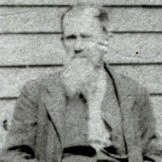 |
| Jacob C. Younkin |
The ledgers provide a fascinating insight into how much the community depended on the tannery and just how many customers it served, especially in the years leading up to the Civil War, before a number of customers migrated to western states. The following excerpts list the accounts of individuals of the Minerd-Minard-Miner-Minor and Younkin families, linked to their Minerd.com biographies.
Legend: The abbreviations "CS" likely meant "calfskin" and "SS" likely meant "sheepskin." Editorial comments by the editor are shown in [brackets].
N. Hartzell [Jr.] – April 6, 1847, cost 95 cents, no further detail.
J. Younkin [Which one?] – mending boots, Feb. 14, 1845, cost 37½ cents – a CS weight 8½ lbs., cost 61 cents, June 18, 1855.
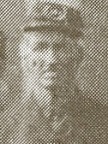 |
| Charles Rose |
Jacob C. Younkin – March 1858, no further detail.
Charles Rose – a CS, weight 9½, June 25, 1850 – half a day of buckwheat and fence, Sept. 17, 1845, cost 20 cents – a CS per Adam Sanner, cost $1.62½, Aug. 28, 1844 – a small CS and SS [sheep skin?] at $1.12½, Aug. 29, 1844 – a pair of bottoms, 68¾ cents, Sept. 4, 1844 – pair of half-soles, cost 25 cents, Sept. 13, 1844 – leather for a pair of shoes, lining and double soles, cost $1.31¼, Oct. 3, 1844 – a piece of a CS, cost $1.00, Oct. 5, 1844 – a pair of “corse” shoes, cost $1.75, June 16, 1845 – a pair of half soles and heels, cost 31¼ cents, Nov. 28, 1845 – a pair of half soles and heels, cost 31¼ cents, June 13, 1846 – fragments of upper, cost 50 cents, April 9, 1847 – "Settled Accts. with John K. McMillen and I remain due him three dollars + forty cts, Charles Rose [signed]," April 9, 1847 – Uppers at 50 cents, Jan. 22, 1849 – Uppers at 50 cents, Feb. 24, 1849 – Hay, cost 50 cents, April 1850 – Bottoms for a pair of shoes, cost 37 cents, May 9, 1850 – A peas of SS, cost 62 cents, June 10, 1850 – A side of upper, cost $1.25, Aug. 1, 1850 – 3 lbs of SS, cost 93 cents, Oct. 7, 1851 – a Qr SS weight 5 ¾ lbs., cost $1.70, Oct. 31, 1851 – A Qr. up, cost $1.37, Oct. 31, 1851 – a Qr. of up, cost $1.25, 2 lbs. of SS, cost 62 cents and a pair of uppers, cost 62 cents, April 19, 1852 – a Qr of SS weight 5¾ lbs., cost $1.80 and a peas of upper, cost 75 cents, Sept. 24, 1854 – Trimming aple trees, April 30, 1859.
Leonard Harbaugh Sr. – March 25, 1848, cost 75 cents [no further detail] – out soles and small bottoms, cost 62½ cents, 1848 – a CS fur son, cost $1.66, June 25, 1849, the CS Brought back – soling and heeling 2 pair of Boots, cost 75 cents and finding leather for the same, 75 cents, 1848 – leather for a pair of Boots made by L. Harbaugh, cost $2.00, March 1848.
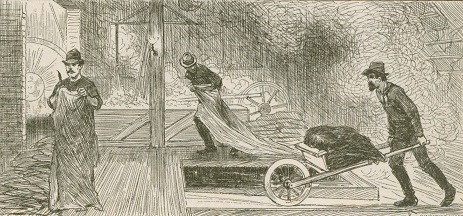 |
"Sweating" the leather hides in a moist room to loosen the root hairs so they can be scraped away. Harper's Weekly, Jan. 25, 1890
|
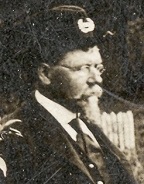 |
| Jerome B. Jennings |
Jerome B. Jennings – a piece of up, cost $2.00, a piece of S Leather, cost $2.03, and 1 pair of out soles for boots, cost 50 cents, April 30, 1868 – footing a pair of Boots, cost $1.50, April 30, 1868
Henry Ream [This was a year before he and his wife Jane left the county and migrated as pioneer settlers to Nebraska] – 7 Bushels Rye, cost $3.50, Dec. 18, 1852.
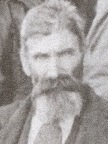 |
| Weasel Jake Younkin |
Jacob W. Younkin Jr. [Nicknamed "Weasel Jake"] – a Qr. of shoe leather weight 6½, cost $2.03, Dec. 18, 1850 – a Qr. of up, cost $1.12 and 8 lbs. Spanish shoe leather, cost $2.40, Sept. 13, 1851 – Mare in pasture, $1.25, 1854 – Sawing done by M. Justice, cost $2.05, Oct. 27, 1851 – a pair of corse boots, cost $3.50, Nov. 4, 1854 – a Bline Bridle, cost $1.75 and sawing done by M. Justice, cost $2.14, April 13, 1852 – hauling 2 loads of Plank, cost 75 cents and 33 lath, 9 feet long + 8-12 feet, 393 feet, cost $1.31, July 9, 1852 – QR shoe leather weight 5½, cost $1.63, Aug. 26, 1852 – Qr. of up, cost $1.62 and 9 lbs. of Beef at 3½, cost 31 cents – pair of boots, cost $3.50, $3.50, Dec. 29, 1852 – pair of bottoms for wife, cost 40 cents, Jan. 14, 1853 – Jacob Schultzes sawing bill (not divided), cost $1.50, March 28, 1853 – 1 lb. of nales, cost 7 cents, April 22, 1853 – 1½ bushels oats, cost 37 cents, April 29, 1853. The above is the amount of a judgment against Samuel Wilhelm on J. Gearhart’s Docket in favour of Jacob W. Younken, involving a mare, 1855 – sawing 810 feet Lath pr. Shultz in the year 1854, cost $1.30 – ¼ bushel seed corn, cost 12 cents, May 16, 1853 – ½ bushel seed corn, cost 25 cents, May 30, 1853 – pair of shoes, cost $1.62, June 21, 1853 – SS weight 9 lbs., cost $2.79, barrel of cider, cost $1.75 and 6 bushels apples at 10 cents, cost 60 cents, Nov. 15, 1853 – 6 lights of glass, 25 cents, Dec. 3, 1853 – paying doctor bill, cost $1.25 and cash lent, cost $10.00, and a pair of shoes for Eliza [or Elija], cost $1.50, Feb. 11, 1854 – 4 bushels oats, cost $1.20 and a pair of shoes, cost $1.75, April 24, 1854 – 14¾ lbs. Bacon at 8 cents, cost $1.18, May 25, 1854 – a letter, cost 5 cents, June 10, 1854 – a sythe, cost $1.00, July 5, 1854 – 2 bushels buckwheat, cost $1.50, July 25, 1854 – a QR of up pr. Wife, cost $1,00, Oct. 26, 1854 – 50 lbs. of Nails at 6¼ cents, cost $3.12, Nov. 1, 1854 – 118 lbs of Beef at 3½, cost $4.13, Nov. 20, 1854 – 3 bushels wheat, cost $3.37, sawing 810 feet Lath done by Jacob Schultz in the year 1854, cost $1.30 and tanning a wolly sheep skin, cost 50 cents, April 3, 1856 – hemstraps and leather, 10 cents, Nov. 15, 1865– a Qr of up weight 3¼ at 65 cents, cost $2.11, June 10, 1867 – a CS weight 3 lbs., cost $3.00, June 10, 1867 – a side up weight 7 lbs. at 60 cents, cost $4.20, a Qr. sole weight 5½ at 45, cost $2.47 and 3 store bills from Walter + Kreger, $19.53, Sept. 23, 1867.
Jacob Younkin [Which one?] – credit on B. roof, cost $1.75, Jan. 4, 1854 – "April 9, 1869, Mr. Jacob Younkin. Sir please pay the barer 1.82 cents by so doing you will oblige me. W.G. Witt." Sawing amounts and whole sawing – To 1 single line at 68 hair strap, cost 78 cents, March 29, 1857 –
Jacob Younkin of Jacob of Jacob – to a pair of Shooes at $1.75, April 1844 – to a Qr of SL at 10 lbs, cost 3.12½, a pair of half soles that was got last winter and forgotten, cost $0.68, Feb. 14, 1845 – paying George L.H. McMillen for mending Boots, cost $0.37½.
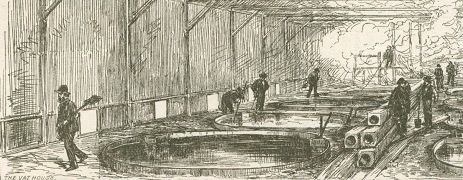 |
Smelly vats in whichraw hides soaked, at a tannery much larger than the McMillans' but illustrative nonetheless. Harper's Weekly, Jan. 25, 1890
|
Harmon Younkin – 3 calfskins at 90 cents apiece, cost $2.70 a murrain cip at $1.00, cip weight 23 lbs at 10 cents/lb, cost $2.30, a small CS at 50 cents, all June 19, 1868 – a CS weight 9 lbs at 10 cents, cost 90 cents, small CS at 50 cents and colt skin and coon skin at $1.00 – a side of up at $3.00, Oct. 2, 1847 – a Qr. of Spannish sole weight 10¾ lbs, cost $3.35, May 25, 1848 – a peece of Bridle leather weight 4 ½, cost $1.33 – 2 Qr SL weight 13½ lbs., cost $4.23 and a Qr. up at $1.37, April 22, 1849 – cipskin got by Jonas H. Yonkin at $2.50, Aug. 11, 1849 – a side of up at $2.69, May 28, 1850 – a side of SL weight 14 lbs., cost $4.37, Oct. 10, 1850 – a SS with the wool on at $1.25, Nov. 13, 1850 – a CS + lining at $1.25, Dec. 26, 1850 – 6 months postage on Advocate, 26 cents, Jan. 1, 1851 – a letter, 5 cents, Oct. 3, 1851 – a Qr of up at $1.37, April 29, 1852 – a Qr SL weight 4¼ lbs., cost $1.33, May 11, 1853 – a Note on John X. [or H.] Younken, cost $4.94, June 29, 1853 – a Qr. of SL weight 8¾ lbs. at 31¼, $2.83 and interest on balance, $1.00, June 18, 1855 – a Qr. of SL weight 8¾ lbs. at 31¼, cost $2.83, June 18, 1855 – a side of up weight 8 lbs. at 70 cents, $5.66, April 1, 1867 – a side of up weight 8 lbs. at 75 cents, cost $6.00 and a CS at $2.50, June 19, 1868 – a peece of Harnace at [illegible], Dec. 11, 1868.
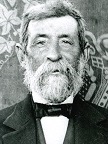 |
| David Harbaugh |
David Harbaugh [Grandfather of Younkin Family News Bulletin editor Charles Arthur "Charleroi Charley" Younkin] – a side of up at $3.25 and a peece of SL at $2.58, Dec. 3, 1866 - by cash, $5.25, Dec. 5, 1866.
Thomas Ream – by cash, 68 cents, July 4, 1849 – a Qr of SL weight 4½ lbs., cost $1.40, May 18, 1846 – tanning a small CS, 37½ cents, May 30, 1846
D. Younkin [Which one?] – April 27, 1868, cost $11.00 [paid by the hand of Susan King, no further detail].
John Frederick Kreger – a Cip at $9.50, Oct. 17, 1866 – a side of harnace weight 8½, cost $2.65, and Whng leather at 20 cents, Jan. 27, 1849 – a side of Harnace at 9 ¾ lbs., cost $3.04 and a peece of Whang leather at 62 cents, Nov. 24, 1852 – a side of up as per Henry, cost $3.00 and a Qr. SL weight 10¼ lbs, cost $3.20, Sept. 13, 1852 – a Qr. of SL weight 8¼ lbs. at 45, cost $3.71, April 21, 1866 – a side of up at 6½ cents at 65, $4.22, Aug 23, 1866 – 20 feet oak boards at $1.25, cost $2.50, Nov. 20, 1866 – a peece of Harnace pr. George at $2.00, Dec. 12, 1866 – a Cip pr George at $5.50, June 29, 1867 – a Carridge at $652.00, cost $55.00, March 15, 1868 – a peace of Leather for straps pr. Fread, cost $1.00, Aug. 17, 1868 – 2 Whangs, cost 60 cents, 2 plank for watter wheel, cost $1.00, 2 loads cole 30 bushels at 8 cents, cost $2.40 and a silke + cradle, cost $1.50, April 13, 1869.
James Knight – March 5, 1844, "settled accounts with John K. McMillen + I remain due him fourteen dollars and eighty-four cents. [signed]" – a Qr. of SL weight 4½ lbs., cost $1.40½, and a bell collar at 33 cents, May 3, 1844 – a side of up at $2.50, Sept. 30 1844 – a Qr of SL weight 5 lbs., cost $1.56¼, and a side of up at $2.75, Nov. 6, 1845 – a side of up at $2.37½ and a Qr of SL weight 7¾ lbs, cost $2.42, Aug. 7, 1847 – a side of up at $2.87½, and a piece of harnace at 75 cents, Oct. 19, 1847.
John Knable – [It's difficult to decipher which line items were his.]
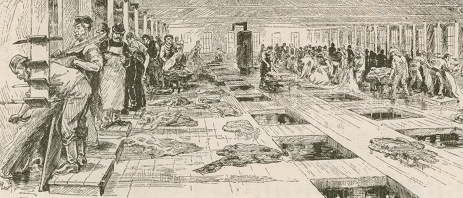 |
Scraping and removing flesh from softened hides. Harper's Weekly, Jan. 25, 1890 |
John K. Rush – [Great-great grandfather of actress/singer Shirley Jones] – 315 feet half price boards pr. J. Younkin at 50 cents, cost $1.57, 96 feet inch oak, cost 96 cents and 72 feet of lath at 24 cents, May 8, 1844 – a letter, cost 25 cents and boards for slay box, cost 25 cents, Aug. 11, 1845 – 6-6¼ crocks, cost 37½ cents, 1846 – ½ a bushel flaxceed, cost 50 cents, May 1, 1847.
Levi Ream – [Father of Norman Bruce Ream, a self-made multi-millionnaire who served on the first board of directors of United States Steel Company and, at his death in 1915, was estimated to be one of the 25 richest men in the nation. These entries are from two decades before Levi's migrations to Illinois and Iowa.] -- to 1¾ bushels of Potatoes at 39¼, June 8, 1844 - to A Qr of S L cut 7 lbs., Ditto to A side of up at -- to A letter to Hiley Jan.'y 27th, 1844, volum 3, Page 182, Nov. 20, 1844 -- to A side of up at [blank], Ditto to A Qr of SL wt 10 lbs., Oct. 10, 1848 -- to A side of harnace wt 12 lbs., Ditto to A small peas of CS at [blank], March 14, 1849.
Levi Ream's entries in 1844 |
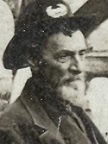 |
| Balaam Younkin |
Balaam Younkin – a CS weight 3¼ lbs at $1.00, cost $3.12 ½, Aug. 9, 1865 – a side of up at 85 cents, cost $4.46, Nov. 13, 1865 – a Qr of SL weight 7½ at 45, cost $3.37, Dec. 21, 1867 – a Qr of up weight 4¼ at 65, cost $2.82, Feb. 22, 1868 – a C Sat, cost $4.75, Dec. 5, 1868 – a Qr of up weight 8½ at 85, $2.97½, Jan. 21, 1869 – sawing bill, cost $11.75.
William Younkin of William – soaling shoes, cost 37½ cents, May 1853 – cash for watch, cost 55 cents, June 1, 1853 – cash for watch, cost $5.00 and paying Jacob $2.00 and Jehu 62 ½ cents, cost $1.62 ½, June 25, 1853.
John M. Younkin of Jacob of John – a Qr of up at $1.12½, cost $1.12½, and a SS at 33 cents, Dec. 4, 1844 – 4¼ lbs. of SL, $1.33, Jan. 26, 1847 – a QR of SL weight 7 lbs., $2.18¾, Nov. 25, 1847 – a 2 inch strap of Harnace, 50 cents, May 8, 1848 – a pair of vamps, 25 cents, Aug. 26, 1848 – a Qr of up, cost $1.50, Oct. 27, 1848 – harnace at 50 cents, Jan. 9, 1849, peece of up at 37½ cents, and 1½ lbs. of SL, cost 42 cents, March 13, 1849 – leather for a pair of shoes, $1.00, Feb. 20, 1851 – 3 years interest on the above, $1.50, and 3¾ lbs of SL at 37⅓, cost $1.24. June 11, 1857.
Thomas Jennings – a damaged side of up at $1.37½ and a side of SL weight 8¼ lbs., cost 2.57¾, Dec. 20, 1844 – a side of SL weight 11½ lbs., cost $3.59, Dec. 25, 1846 – a side of SL weight 11¾ lbs., cost $3.67, Dec. 18, 1848 – a side of SL weight 9¼, cost 50 cents, finishing murren up at 50 cents, 2 bridle rains + 2 harnes wings, 60 cents, Nov. 20, 1850.
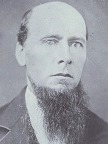 |
| Henry Younkin |
Isaac Younkin [This was a year prior to his and his wife Rebecca's migration to Indiana in 1858] – 3¾ lbs of SL, cost $1.27, Jan. 2, 1847 – a QR of SL weight 7 lbs at 33⅓, cost $2.33⅓, Feb. 23, 1857.
Henry Younkin – a pair of harnace at 6 lbs., cost $1.87½, a Qr. of SL weight 3¼ lbs., cost $1.01, 4½ lbs. cut of the above peece of Harnace, cost $1.41, Oct. 10, 1844 – 3 straps of Harnace, weight 4 lbs. at 37½, cost $1.50, Jan. 4, 1845 – a side of up, cost $2.25, March 1, 1845 – a letter at 6 cents, March 1, 1845 – a Messenger + 6 months postage, cost $1.26, July 1, 1845 – 3 months postage, 13 cents, Oct. 1, 1845 – a side of up at $2.75, and 5½ lbs. of SL, cost $1.72, Oct. 17, 1846 – a collar at $1.25 and boot in dividing C. Skins, 25 cents, April 5, 1847 – a side of up at $2.50, Sept. 27, 1847 – a padded collar at $1.62½, Jan. 12, 1848 – 17 lbs of Harnace at 25, cost $4.25, for iron 17-44 + 14¾, cost $4.25, March 18, 1848 – tanning a CS at 87½ cents and tanning 2 wooly SS at 62½, Jan. 26, 1849 – tanning a Muren Cip at $1.00, March 2, 1849.
Otho Ream [This in the years prior to his migration to Indiana and Missouri] – a Qr. of SL weight 7½ lbs., cost $2.34¼.
“Yung” Henry Minerd [a.k.a. Henry A. Miner] – a Qr. upper at $1.25 and 2¾ lbs SL, cost 87 cents, June 10, 1850 – a Qr. SL weight 7½ lbs., cost $2.33 and a Qr. up at $1.50, Dec. 7, 1850 – 2 bushels of potatoes at $1.00, 1851 – a grownhoggskin at 31¼ cents, Nov. 3, 1851 – a Qr. of SL weight 5¾ lbs., cost $1.79, Jan. 6, 1852.
Marcellus Andrews - to A CS at [blank], April 19, 1868 - lot gr of Up, Ditto to SL for a pair of Boots, to Difference between S Skins, Oct. 15, 1867.
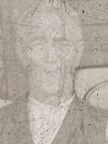 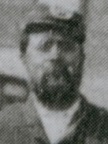 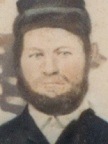 |
| L-R: "Young" Henry A. Miner, Marcellus Andrews, Frederick J. Younkin |
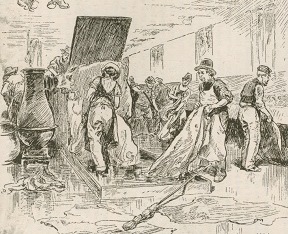 |
| Washing tanned hides. Harper's Weekly, Jan. 25, 1890 |
Daniel Younkin [in the years before his migration to West Liberty, Iowa] – paching mittens, 31 cents, Jan. 25, 1857 – 1½ yards cloth at $3.00, cost $4.50, March 21, 1857 – double halfsoles, cost 31 cents, and one halfsole, 10 cents, March 28, 1857 – apron, 75 cents, April 29, 1857.
John Ream [which one?] – "settled accounts John K. McMillen and balance due him one dollar + twenty 3 cents and a mistake of 25 cents [signed], March 26, 1845."
Michael Firestone [Includes the note “(son of Hanna Ancil)”]– to 3½ lbs. of SL (pr. John Ancil’s sons), cost $1.16, May 11, 1857.
Frederick Younkin of Jacob [a.k.a. Frederick J. Younkin] – a pair of half soles, cost 25 cents, June 23, 1845 – a Qr of up at $1.62 and 7½ lbs of SL, July 26, 1847 – a set of Chares at $6.00, July 28, 1848 – a CS at $1.37, April 14, 1849 – 2 Qr SL weight 11½ lbs., cost $3.58, Oct. 6, 1849 – a Qr SL weight 2¾ lbs., cost $3.04, Sept. 23, 1850 – a pair of corse Boots at $3.50, Nov. 4, 1851 – a CS at $1.37, Dec. 5, 1852 – 2 Barrals of Cider at $1.50, cost $3.00, 2 barrals apples, 75 cents and garden + meddow lot, $1.00, Nov. 12, 1853 – settled accounts with John K. McMillen + balance due him two dollars and 19 cents, Dec. 21, 1854 [signed] – 7½ lbs of sole at 31¼, cost $2.34, March 27, 1860 – 229 feet Poplar Boards, $2.29 and a side of up at $5.95, Oct. 24, 1868.
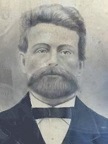 |
| Frederick F. Younkin |
Frederick Younkin of Frederick [a.k.a. Frederick F. Younkin] – Messenger in county, cost 50 cents, Jan. 15, 1845 – half the postage, 19½ cents, Oct. 1, 1845 – side harness weight 12¼ lbs., cost $3.83, Nov. 25, 1848 – a side of up at $3.00, Dec. 4, 1848 – a side of up at $1.37½, July 9, 1850 – a side of SL weight 11 lbs., cost $3.43, and a side of upper at $3.37, Oct. 16, 1850 – a side of harnace per Jacob, weight 13½, cost $4.20, Dec. 24, 1850 – to papers postage one year, 52 cents, June 30, 1851 – a side of up at $2.87, Oct. 8, 1851 – 2 sides of harnace weight 21 lbs per Jacob, $6.56, Dec. 26, 1851 – 6 years interest, $4.06, March 1858 – tanning a CS, [no cost given], Nov. 30, 1863 – a side of harnace weight 13 lbs at 40 cents, cost $5.20, Dec. 7, 1863 – boot in dividing CS 50 cents + tan on upper + CS 40 cents, Oct. 3, 1864.
Aaron Schrock – a CS at $1.75, May 18, 1846 – a side of SL per Wm. Vought weight 10½, cost $3.28, May 25, 1846 – a side of harnace weight 8¾ lbs., cost $2.74, per John Miller, Sept. 22, 1846 – a CS at $1.75, Sept. 4, 1848 – a side of SL weight 8¾ the left at [illegible], cost $2.74, Sept. 15, 1848 – a side of Harnace weight 13½ lbs., cost $4.21, Dec. 14, 1848 – "settled accts with Aaron Schrock + balance due Me $7.22. [signed]"
John Younken (Yanke) [This is the earliest known usage of the “Yankee” nickname] – a pair of high uppers at 62 cents, March 31, 1846.
Earliest reference to the nickname "Yankee John" Younkin, 1846 |
John Minerd – "settled Accts with John K. McMillen + I remain due him Five Dollars + Ninety cents, [signed]." April 13, 1846 – a CS at $1.50, and 5 lbs SL at $1.56½ and a QR up at $1.37½, March 10, 1851 – 3 Bushels Potatoes at 50 cents, cost $1.50 and a letter, 5 cents, May 3, 1852 – a QR of up per Charles Rose at $1.25, 5¼ lbs. SL at $1.63 and 2 letters sent by Charles Rose, 10 cents, April 19, 1852 – 20 buncles cutting straw, 10 cents, May 5, 1852 – a QR SL weight 6¾ lbs., cost $2.12, Feb. 12, 1853 – a Bell Collar at 15 cents, May 27, 1853 – a QR of SL weight 4¾ lbs., cost $1.49, Sept. 18, 1855 – 2 lbs. of SL at 33⅓, cosg $1.49, May 20, 1857.
Jonas H. Younking – a QR up at $1.43, July 3, 1847 – leather for a pair of Boots made by L. Harbaugh, $2.00, March 1848 – one month cow pasture, 48 cents, April 1851 – 10 months paper postage, July 1, 1851.
Mary Younken (Widdow) [Probably Mary “Polly” (Hartzell) Younkin, whose husband John J. died in 1839] – 3 months cow pasture at 62½, cost $1.87½ and a QR of up at $1.12, Oct. 20, 1848 – a Qr of S weight 4½ lbs. at 28, cost $1.26, May 2, 1849 – a QR of SL per James, weight 5¾ lbs., cost $1.61, June 2, 1849 – a CS at $1.50, and 4¾ lbs. SL, cost $1.33, March 18, 1850 – QR SL weight 7¼ lbs., , cost $1.81 and a CS per Jonas at $1.37½, Jan. 1, 1852.
Leonard Harbaugh Jr.'s entries in 1867 |
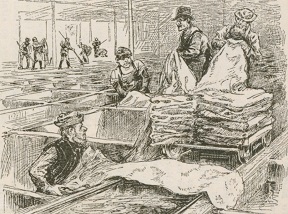 |
| Vat house. Harper's Weekly, Jan. 25, 1890 |
Leonard Harbaugh Jr. [Father of Minerd family historian Allen Edward Harbaugh, “The Mountain Poet” of Mill Run, PA] – a QR SL weight 6 lbs., cost $1.87, and a QR of up at $1.00, Dec. 7, 1847 – a peece of CS at 37½, Dec. 28, 1847 – a QR SL weight 3 lbs., cost 93¾ cents, a black grain CS, cost $1.25, shoe bottoms, cost $1.17, boarding 19 weeks, $19.00, to washing, $2.25, crediting Lotty Nichola, 75 cents, 3 CS at $3.75, a pair of boots taken away to sell, price $4.00, March 1848 – a side and QR of upper, cost $4.56, June 13, 1853.
Thomas R. King – a side up at $2.00, cost $2.75, July 31, 1848 – uppers for a pare of shews, cost 62½ cents, Feb. 21, 1849 – a side of up, cost $3.00, and to Reuben making Blind Bridle + finding bits + buckles, July 2, 1849 – tanning a wooley SS at 62½ cents, Jan. 8, 1851 – a side of up per Moses Ramsbiger, cost $1.87½, April 15, 1852 – a QR of SL per Wife at 4¾ lbs., cost $1.33 – to sawing 358 feet walnut by J. Shultz in the spring of 1852, $1.75 and 187 feet poplar, 70 cents, Nov. 11, 1853.
Jacob Younken [Which one?] -- Carpenter – a side of upper at $2.00 and a QR SL weight 4¼ lbs., $1.06¼, Oct. 29, 1853 – a side of up at $2.50, April 29, 1854 - 4½ lbs of SL, cost $1.40, [illegible] 24, 1855.
Frederick Dull – 5 lbs. SL, cost $1.56, June 18, 1852.
Jacob Minard [a.k.a. Jacob Minerd III] – "settled accounts with J.K. McMillen + I remain due him four dollars + thirty seven cents, May 15, 1852 [signed]." – 7 years interest on the above, $1.84 – balance due on mare $5.00 and 4 years interest $1.20, cost $6.20, March 19, 1855.
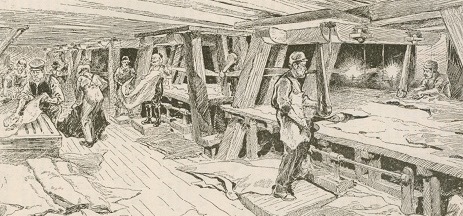 |
Finishing the leather. Harper's Weekly, Jan. 25, 1890 |
Michael Weimer [Likely the son of Michael and Sarah (Younkin) Weimer and a future pioneer settler of Iowa] – a deer skin at 50 cents, Sept. 14, 1853 – paying A. Feltkirkner, cost $3.75, blacking scraps of belowsleather, 25 cents, and a letter postage [no cost listed], Jan 2, 1854 – a QR SL weight 8 lbs., cost $2.50, Jan. 23, 1854 – a set of chairs, cost $6.00, April 28, 1854 – 8 lbs. of wool at 25 cents, cost $2.00, a letter [no cost listed] and a note on Thomas T. King, $9.65, June 5, 1854 – brass, 98 cents and accafortis, 18¾, Sept. 1854 – a CS for Ason, 75 cents Sept. 20, 1854 – a pair of uppers, 62½ and a butter keg 37½, Oct. 24, 1854 – uppers for Boots + Cramping, $1.37½, Nov. 1854 – a Saddle at $15.00, March 19, 1855 – 18¼ lbs. veal [no cost listed], June 15, 1855 – iron, $1.72, Aug. 24, 1855.
Samuel Phillippi – [Believed to be the husband of Mary Ann “Polly” (Younkin) Phillippi] – halfsoles + heels to Franklin, 25 cents, May 20, 1857 – a hat, $1.75, May 23, 1857 – 3 bushels wheat at $1.50, cost $4.50, 3 bushels corn and 3 buckwheat at 75, cost $4.50, and Williams fine shoes to Franklin, cost $1.50, July 11, 1857 – 20 dollar gold peece, cost $20.00, Aug. 26, 1857 – Franklin corse shoes, $2.00, Sept. 21, 1857 – cash to H. Tressler in change, cost $2.50, Oct. 3, 1857 – store bill, cost $2.94, and a shirt to Franklin, 37½ cents, Oct. 31, 1857 – 179 lbs. beaf at 3¾ cents, cost $6.71, Dec. 1, 1857 – 6 bushels wheet, $6.00, Jan. 23, 1858 – 4½ bushels wheet, $4.52, June 5, 1858 – paying for Hat for Harmon, 50 cents, July 1858 – souling, heeling + paching boots, 62 cents, Aug. 1858 – a pair of shoes, $2.00, Sept. 4, 1858 – hymn book, 50 cents, Oct. 12, 1858 – 2 yards cloth at $3.00, cost $6.00, Nov. 6, 1858 – 137 lbs. at 3½ cents, $4.86, Nov. 29, 1858 – Harmon Corse Boots, $3.75, Dec. 10, 1858 – soles for Harmons Boots, 37 cents, Feb. 3, 1859.
Copyright © 2021 Mark A. Miner